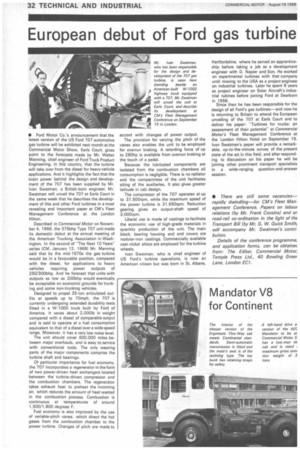European debut of Ford gas turbine
Page 34

If you've noticed an error in this article please click here to report it so we can fix it.
• Ford Motor Co.'s announcement that the latest version of the US Ford 707 automotive gas turbine will be exhibited next month at the Commercial Motor Show, Earls Court, gives point to the forecasts made by Mr. Walter Manning, chief engineer of Ford Truck Product Engineering, in this country, that the turbine will take over from the diesel for heavy vehicle applications. And it highlights the fact that the brain power behind the design and development of the 707 has been supplied by Mr. Ivan Swatman, a British-born engineer. Mr. Swatman will unveil the 707 at Earls Court in the same week that he describes the development of this and other Ford turbines in a most revealing and important paper at CIVI's Fleet Management Conference at the London Hilton.
Described in Commercial Motor on November 4, 1966, the 375bhp Type 707 unit made its domestic debut at the annual meeting of the American Trucking Association in Washington. In the second of -The Next 10 Years" series ICM. January 12, 19681 Mr. Manning said that by the mid-1970s the gas turbine would be in a favourable position, compared with the diesel, for applications to heavy vehicles requiring power outputs of 250/300bhp. And he forecast that units with outputs as low as 200bhp would eventually be acceptable on economic grounds for tru nking and some non-trunking vehicles.
Designed to propel 35-ton articulated outfits at speeds up to 70mph, the 707 is currently undergoing extended durability tests fitted in a W-1000 truck built by Ford of America. It saves about 2,000lb in weight compared with a diesel of comparable output and is said to operate at a fuel consumption equivalent to that of a diesel over a wide speed range. Moreover, it has a very low noise level.
The unit should cover 600,000 miles between major overhauls, and is easy to service with conventional tools. The only wearing parts of the major components comprise the turbine shaft and bearings.
Of particular importance for fuel economy, the 707 incorporates a regenerator in the form of two power-driven heat exchangers located between the turbine-driven compressor and the combustion chambers. The regenerator takes exhaust heat to preheat the incoming air, which reduces the amount of heat wasted in the combustion process. Combustion is continuous at temperatures of around 1,500/1,800 degrees F.
Fuel economy is also improved by the use of variable-pitch vanes, which direct the hot gases from the combustion chamber to the power turbine. Changes of pitch are made to accord with changes of power output.
The provision for varying the pitch of the vanes also enables the unit to be employed for overrun braking. A retarding force of up to 2801-ip is available from overrun braking at the touch of a pedal.
Because the lubricated components are isolated from the combustion chambers oil consumption is negligible. There is no radiator and the compactness of the unit facilitates siting of the auxiliaries. It also gives greater latitude in cab design.
The compressor of the 707 operates at up to 37.500rpm, while the maximum speed of the power turbine is 31,650rpm. Reduction gearing gives an output-shaft speed of 3.00Orpm.
Liberal use is made of castings to facilitate the economic use of high-grade materials in quantity production of the unit. The main block, bearing housing and end covers are nodular-iron castings. Commercially available cast-nickel alloys are employed for the turbine wheels.
Ivan Swatman. who is chief engineer of US Ford's turbine operations, is now an American citizen but was born in St. Albans,
Hertfordshire, where he served an apprenticeship before taking a job as a development engineer with D. Napier and Son. He worked on experimental turbines with that company until moving to the USA as a project engineer on industrial turbines. Later he spent 6 years as project engineer on Solar Aircraft's industrial tubines before joining Ford at Dearborn
in 1956. Since then he has been responsible for the
design of all Ford's gas turbines—and now he is returning to Britain to attend the European unveiling of the 707 at Earls Court and to deliver his paper: "Turbines for trucks: an assessment of their potentialat Commercial Motor's Fleet Management Conference at the London Hilton Hotel on September 19. Ivan Swatman's paper will provide a remarkable, up-to-the-minute survey of the present state of the art. in this field, and after responding to discussion on his paper he will be joining other prominent transport specialists in a wide-ranging question-and-answer session.
• There are still some vacancies— rapidly dwindling—for CM's Fleet Management Conference. Papers on !about relations (by Mr. Frank Cousins) and on road-rail co-ordination in the light of the Transport Bill (by Mr. G. W. Ouick Smith, will accompany Mr. Swatman's contribution.
Details of the conference programme, and application forms, can be obtainec from.. The Editor, Commercial Motor, Temple Press Ltd., 40 Bowling Greer Lane, London EC1.




































































































